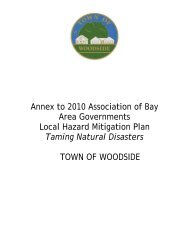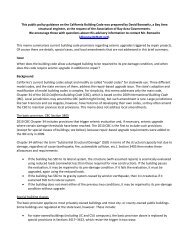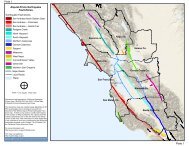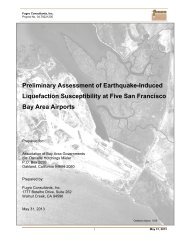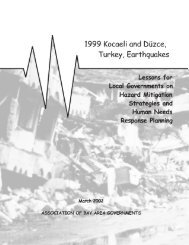Safe Enough to Stay - ABAG Earthquake and Hazards Program
Safe Enough to Stay - ABAG Earthquake and Hazards Program
Safe Enough to Stay - ABAG Earthquake and Hazards Program
- No tags were found...
You also want an ePaper? Increase the reach of your titles
YUMPU automatically turns print PDFs into web optimized ePapers that Google loves.
<strong>Safe</strong> <strong>Enough</strong> <strong>to</strong> <strong>Stay</strong>San Andreas earthquake. In every neighborhood in the city, morethan 10 percent of the housing units would become unsafe <strong>to</strong>occupy. The neighborhoods that will see the most damage are thosewith large numbers of multifamily buildings, which are generally morevulnerable than smaller residences, <strong>and</strong> those that have significantareas of soft or liquefiable soils, which can experience magnifiedshaking <strong>and</strong> ground failure. (See Figure 2, page 13.) Figure3 (page 14) shows estimates of the percentage of unsafe units inall districts. Estimates suggest that the Marina district would be hithard, with nearly half of housing units there unsafe <strong>to</strong> occupy. TheRichmond district would also suffer significant amounts of damagedhousing, with an estimated 35 percent of units unsafe <strong>to</strong> occupy due<strong>to</strong> the type of housing in the neighborhood <strong>and</strong> its proximity <strong>to</strong> theSan Andreas Fault.Known structural deficiencies are behind this predicted damage.Wood-frame soft-s<strong>to</strong>ry residences with three or more units wouldaccount for two-thirds of the housing units citywide that could notbe occupied. Typically, a soft-s<strong>to</strong>ry building has large openings atthe ground level, such as garage doors or s<strong>to</strong>re windows, <strong>and</strong> fewinterior walls, making the ground floor much weaker <strong>and</strong> moreflexible than the s<strong>to</strong>ries above. In an earthquake, the ground level cansway excessively <strong>and</strong> collapse. Construction patterns are differentin various parts of the city, so the types of structures responsible forhousing damage would vary by district, as shown in Figure 4 (page15).In the expected earthquake, all neighborhoods would experienceheavy damage, but some would see more housing loss than others.Estimated housing losses range from 11 percent in the Inglesidedistrict <strong>to</strong> an alarming 50 percent in the Marina. The followingsections explore what some of the consequences of this housingdamage might be in selected districts with large housing losses —Down<strong>to</strong>wn, the Marina, the Mission <strong>and</strong> Western Addition — <strong>and</strong>how damage <strong>to</strong> specific districts would affect the city as a whole.For more about the varying impacts on different neighborhoods, seeAppendix I, page 32.Down<strong>to</strong>wnIn addition <strong>to</strong> the down<strong>to</strong>wn financial district, CAPSS defines thisdistrict as including the Tenderloin, the south slope of Nob Hill, muchof SOMA <strong>and</strong> most of China<strong>to</strong>wn. Encompassing some of the oldest,densest <strong>and</strong> most his<strong>to</strong>rically rich parts of the city, the down<strong>to</strong>wnarea contains approximately 54,000housing units, the largest number of anydistrict, in addition <strong>to</strong> housing more than250,000 of San Francisco’s jobs. It is alsothe city’s least affluent district, measuredby median household income, with largeconcentrations of single-room occupancy54,000Housing units15,000Units rendered unusableby the expected earthquakebuildings <strong>and</strong> other types of affordable housing. Many elderly people,new immigrants <strong>and</strong> non-English speakers live here. After theexpected earthquake, nearly 15,000 housing units down<strong>to</strong>wn (27percent) would be rendered unusable. Approximately half of theseunits are in wood-frame soft-s<strong>to</strong>ry buildings with three or more units;the rest are located in non-wood structures, including older concreteframebuildings <strong>and</strong> retrofitted unreinforced masonry buildings thatare still vulnerable. These non-wood structures are particularlyproblematic because some of them house a large number of units<strong>and</strong> they can be difficult <strong>and</strong> costly <strong>to</strong> retrofit. Housing losses in thisdistrict would be expected <strong>to</strong> displace many lower-income residentswho would depend heavily on city services after the disaster.flickr user reallocalcelebrity (John Morrison)16 SPUR Report > January 2012




